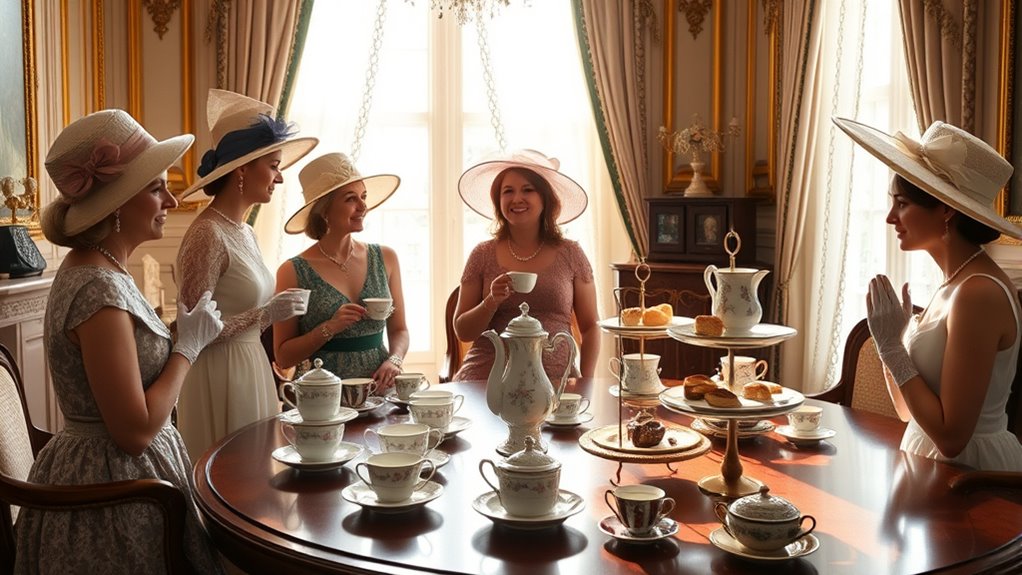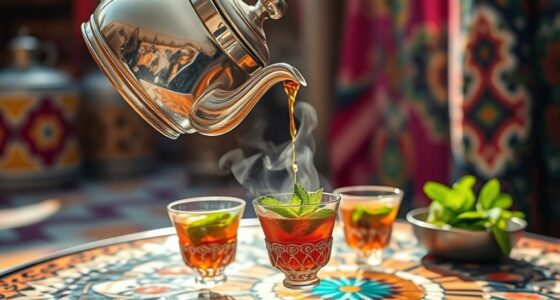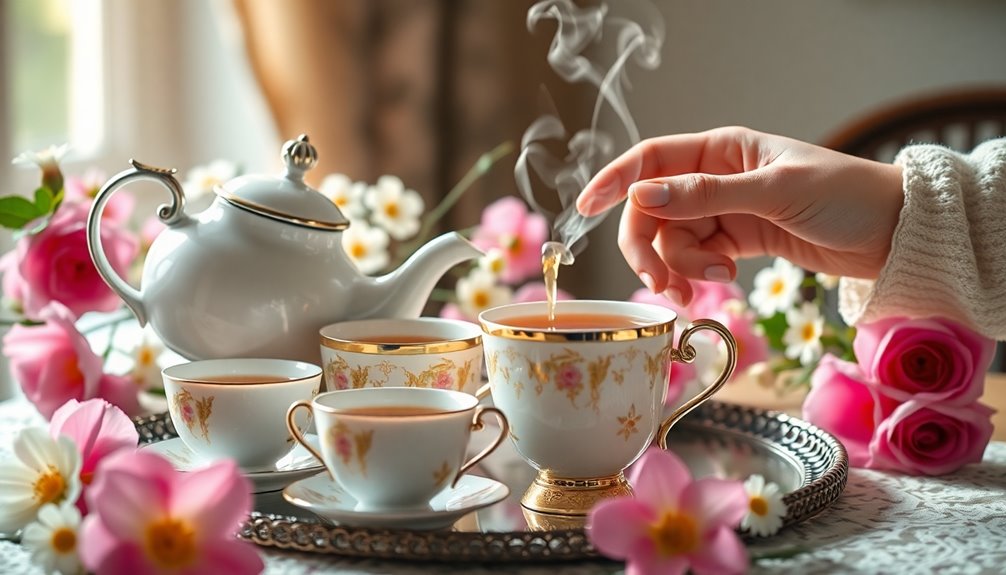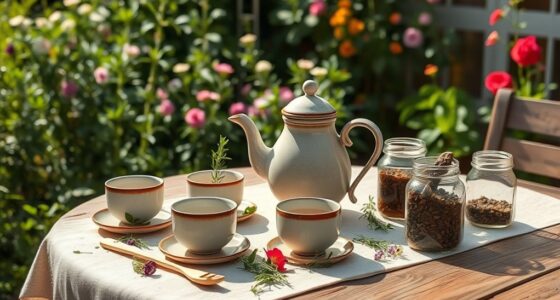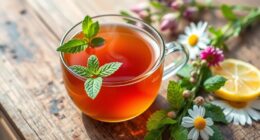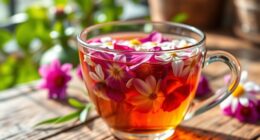Tea transformed from a luxury import into a key part of British social life, inspiring the refined etiquette we recognize today. As it grew in popularity among the upper classes, formal ceremonies and proper manners developed around serving and drinking tea. This led to the rise of afternoon tea as a social ritual, emphasizing civility, elegance, and community. Keep exploring, and you’ll discover how these traditions shaped British culture and social customs over centuries.
Key Takeaways
- Tea’s transition from luxury to social ritual fostered formal afternoon gatherings emphasizing civility and shared cultural values.
- The development of specific tea-serving etiquette reinforced social distinctions and manners during mid-afternoon social hours.
- Afternoon tea became a structured social event, promoting conversation, civility, and community among different social classes.
- The use of fine china, proper utensils, and presentation elevated tea drinking into an elegant, refined daily tradition.
- These rituals and customs helped shape British social identity, emphasizing grace, decorum, and social cohesion.
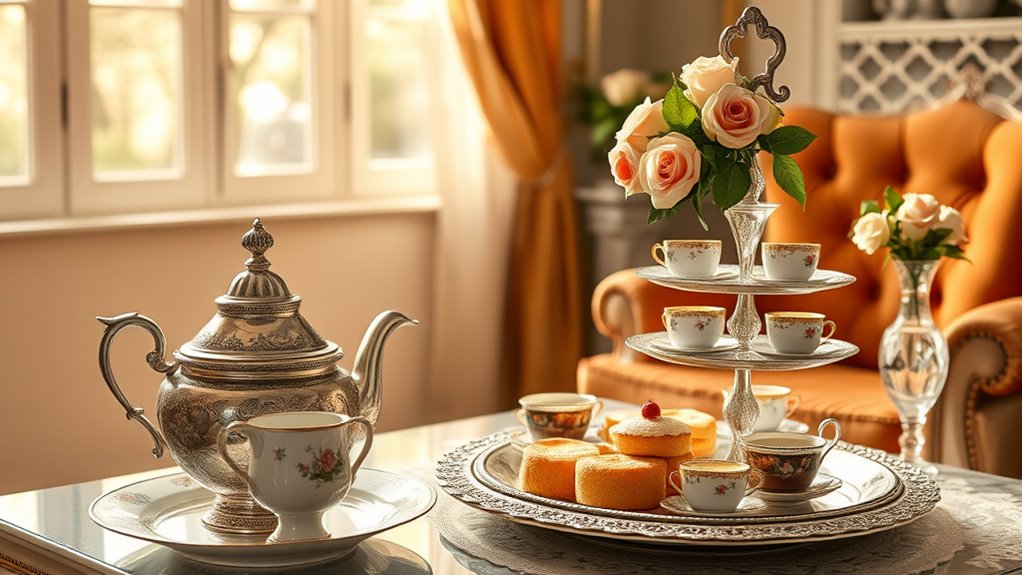
Tea, once a luxury imported from distant lands, quickly became more than just a beverage in Britain; it sparked the development of a refined social ritual known as afternoon tea. As tea grew in popularity, it transformed from a simple refreshment into a central element of social customs. You might imagine how, in the early 19th century, tea ceremonies began to take shape among the upper classes, serving as occasions for conversation, relaxation, and display of good taste. These ceremonies weren’t just about drinking tea—they were carefully curated events that emphasized elegance and civility.
The rise of tea as a social practice led to the codification of afternoon tea as a distinct tradition. It’s not just about sipping a warm cup; it’s about participating in a ritual that brings people together at a set time—typically mid-afternoon—when you pause your daily activities to enjoy this leisurely break. During these gatherings, the social customs surrounding tea became as important as the beverage itself. You’d set out fine china, delicate cups, and elegant linens, creating an atmosphere of refinement. Serving tea was an art, involving proper etiquette and presentation that signaled your social standing and good manners.
In these social customs, the act of pouring tea, offering it to others, and engaging in polite conversation became key elements. You learned to handle the utensils gracefully, often using tongs for sugar cubes and a milk jug to achieve the perfect blend. These details weren’t trivial; they reinforced social bonds and demonstrated your adherence to tradition and decorum. Over time, the etiquette of tea drinking evolved into a symbol of civility and good taste, shaping the way you interacted during social gatherings.
Furthermore, tea ceremonies played a role in establishing a sense of community among the social classes. While initially reserved for the aristocracy, the customs gradually seeped into broader society, influencing middle classes and eventually becoming a national pastime. You could see how these social customs fostered a shared sense of identity, turning casual tea-drinking into a sophisticated ritual that highlighted civility and social harmony. You might also note how the development of tea etiquette contributed to the formalization of social interactions in Britain. You could see how these social customs fostered a shared sense of identity, turning casual tea-drinking into a sophisticated ritual that highlighted civility and social harmony. The more you participated in these rituals, the more you embraced a lifestyle rooted in elegance and tradition—values that became central to British identity.
In essence, tea’s journey from distant import to cultural cornerstone reflects how a simple beverage can influence social structure. The development of tea ceremonies and social customs around afternoon tea created a refined etiquette that still influences British culture today, emphasizing grace, civility, and the importance of taking a moment to connect with others.
Frequently Asked Questions
When Did Afternoon Tea Become a Widespread Social Norm in Britain?
You might wonder when afternoon tea became a widespread social custom in Britain. It started in the early 19th century, around the 1840s, influenced by the tea origins brought from China and India. As tea became popular among the upper classes, it evolved into a daily social ritual. By the late 1800s, afternoon tea had spread across society, establishing a cherished tradition that defined British social customs and etiquette.
Were There Regional Differences in Afternoon Tea Customs Across Britain?
You’ll find regional variations in afternoon tea customs across Britain, shaped by local cultural influences. In some areas, like Cornwall, thinner bread and local scones are preferred, while in Yorkshire, hearty accompaniments reflect regional tastes. These differences develop from diverse traditions, climate, and social norms, making afternoon tea a rich tapestry of regional customs. You can appreciate how local culture influences the way you enjoy this beloved British tradition.
How Did the Invention of Specific Teaware Influence Etiquette?
Imagine the teapot’s quiet revolution—its evolution shaping etiquette standards you follow today. As teaware became more refined and specialized, it sparked a shift in social customs. You now handle delicate cups and saucers with grace, following a tradition that’s rooted in historical teaware design. This evolution didn’t just change tools; it transformed the very way you enjoy your afternoon, elevating a simple break into an elegant ritual.
Did Other Countries Adopt British Afternoon Tea Traditions?
You’ll find that many countries have embraced British afternoon tea traditions through cultural adaptations and global influences. While some nations, like Japan and India, blend their own customs with the British style, others adopt it more directly. These influences spread via travel, media, and international relations, allowing you to see how British afternoon tea has become a symbol of elegance worldwide, showcasing a fascinating mix of cultural adaptations and global influences.
What Role Did Prominent Figures Play in Popularizing Afternoon Tea?
You see, prominent figures like royalty and celebrities played a big role in popularizing afternoon tea. Royal patronage, especially from Queen Victoria, elevated its status, making it a fashionable social event. Celebrity endorsements also helped spread its popularity beyond Britain. When influential people embraced afternoon tea, you and others saw it as a chic, refined tradition to enjoy, solidifying its place in British culture and inspiring others worldwide to adopt the custom.
Conclusion
As you picture a delicate china cup shimmering in the afternoon sun, you realize how tea transformed British culture. The gentle clink of teaspoons and the soft murmur of conversation create a soothing rhythm, inviting relaxation and connection. Tea’s warm embrace nurtured an elegant tradition, turning ordinary afternoons into cherished rituals. So next time you sip your tea, remember how this simple act helped shape a refined and timeless dance of social grace.

